Produktkategorien
Neue Produkte
Das Team Uno-X fährt bei der Tour de France 2024 ein radikales, noch nie veröffentlichtes Aero-Rennrad.
Das von der taiwanesischen Marke (und Uno-X-Teamsponsor) Dare hergestellte Fahrrad widersetzt sich dem vorherrschenden Trend zu Allround-Fahrrädern und verfolgt stattdessen einen hyper-aeroben Ansatz, bei dem das Gewicht scheinbar kaum berücksichtigt wird.
Vor dem Rennstart im italienischen Florenz konnten wir uns das neue Bike im Teamhotel von Uno-X aus der Nähe ansehen.
Könnte dies das Fahrrad sein, das dem Uno-X-Team zu seinem ersten Sieg beim größten Rennen des Sports verhilft?
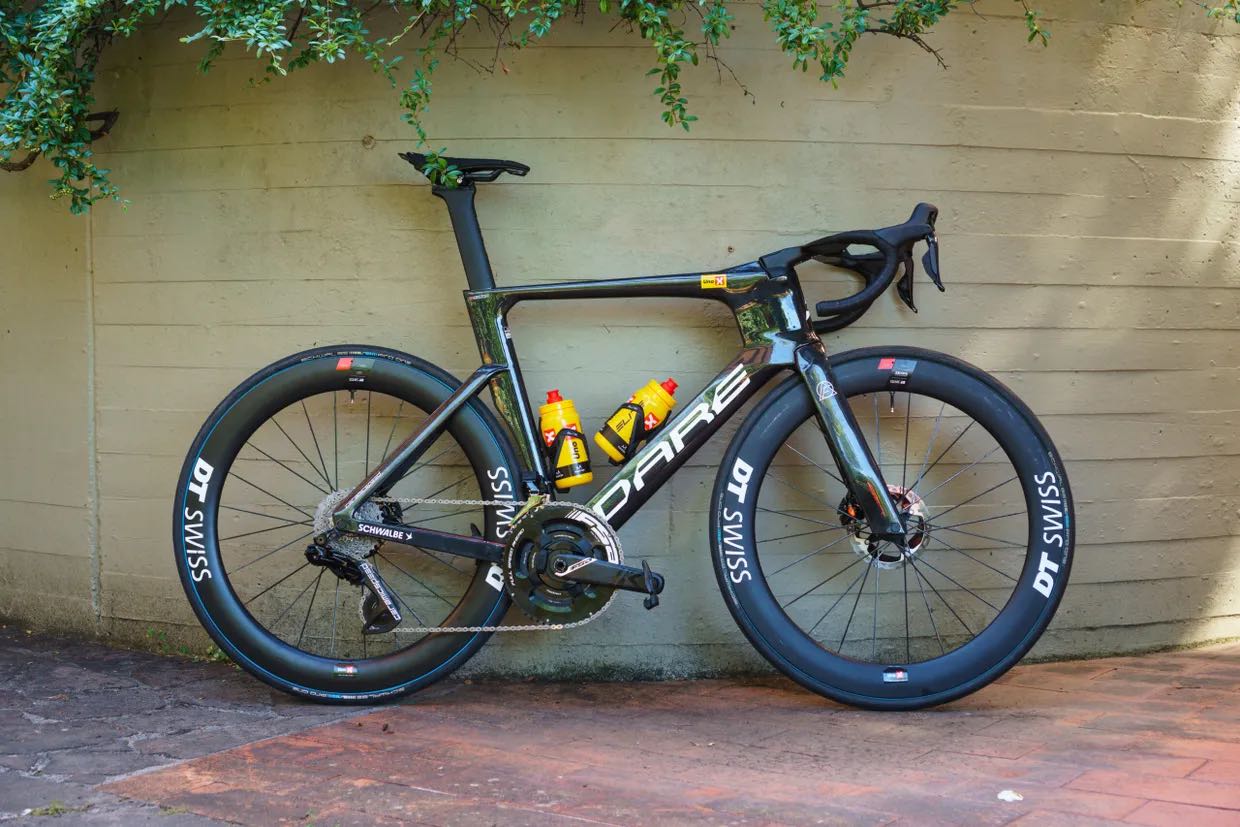
Rückkehr des Aero-Bikes
In den letzten Jahren haben viele namhafte Marken den Verzicht auf spezielle Aero-Rennräder zugunsten von Modellen mit einem ausgewogenen Verhältnis zwischen aerodynamischer Leistung und geringem Gewicht erlebt.
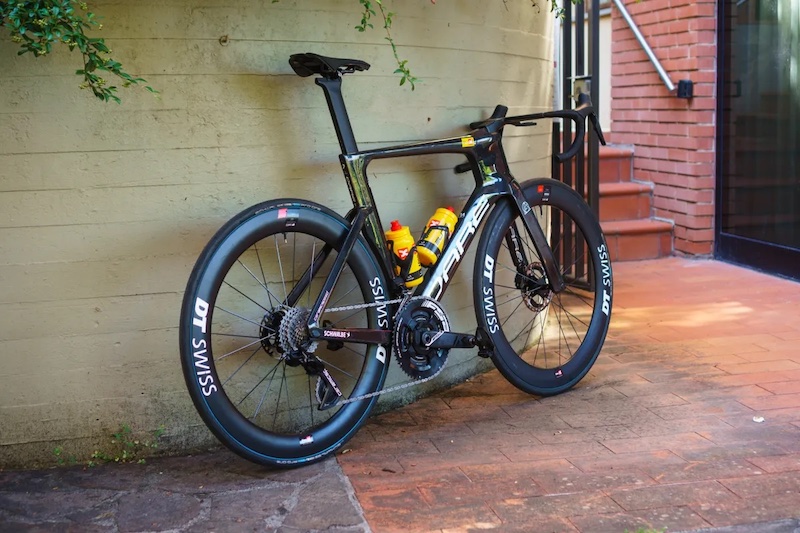
Specialized etwa hat sein S-Works Venge bekanntlich auf die lange Bank geschoben, als es 2020 das S-Works Tarmac SL7 herausbrachte, während Trek mit der kürzlich angekündigten achten Generation des Madone SLR das Ende seines Émonda einläutete.
Ebenso wurde mit der Veröffentlichung eines leichten Giant Propel Advanced SL im Jahr 2022 der legendäre TCR der Marke nur noch auf einen eingeschränkten Einsatz in der WorldTour beschränkt.
Dare scheint den entgegengesetzten Ansatz zu verfolgen, mit einem Design, das eher anderen rein aerodynamischen Rennrädern wie dem Cervélo S5, dem Ribble Ultra SLR und dem Cannondale SystemSix Hi-Mod ähnelt.
Soweit wir wissen, scheint das neue Aero-Rennrad von Dare „Velocity Ace“ zu heißen, da dieser Name auf dem Unterrohr aufgedruckt ist.
Es handelt sich höchstwahrscheinlich um ein Update des bestehenden Aero-Bikes der Marke, dem VSRu. Das neue Bike verdoppelt jedoch die aerodynamischen Optimierungen, mit tieferen Tragflächenrohrformen überall und einer Konstruktion, die ganz auf Geschwindigkeit ausgerichtet ist.
Rundum-Tiefprofilrohre
Das Steuerrohr ist eines der auffälligsten Teile des Velocity Ace.
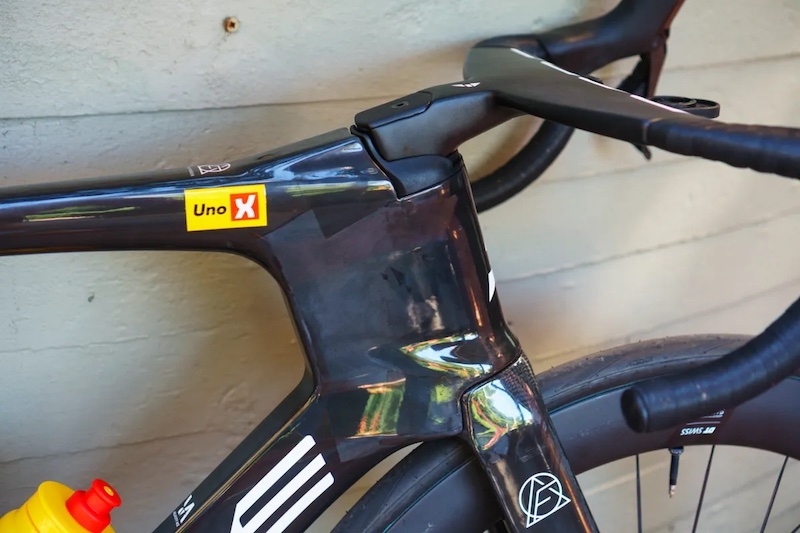
Es verfügt über ein tiefes, abgeflachtes Tragflächenprofil und erhebt sich vom Oberrohr bis zur Rückseite des neuen integrierten Lenkers des Fahrrads (mehr dazu später).
Am unteren Ende ist das Steuerrohr so geformt, dass der Luftstrom von der Gabelkrone kontrolliert werden kann.
Von vorne betrachtet hat das Steuerrohr die Form einer Sanduhr. Es verjüngt sich zwischen den oberen und unteren Steuersatzlagern, um den Luftwiderstand weiter zu verringern.
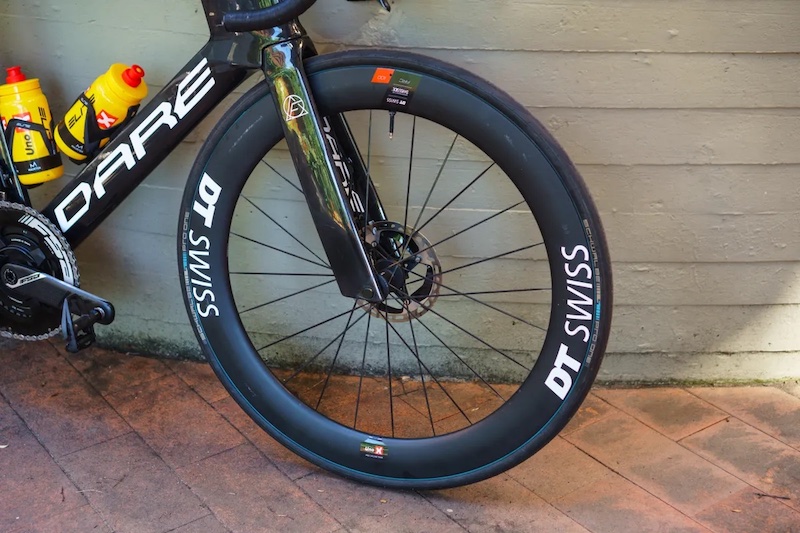
Während die Gabel des VSRu nach unten hin leicht verjüngt ist, bleiben die schmalen Gabelbeine der neuen Gabel ganz unten tief.
Während das Unterrohr beim VSRu eine kleine Aussparung für das Vorderrad hatte, verfügt das Velocity Ace über ein gerades Unterrohr mit einem tieferen, breiteren, abgeschnittenen Tragflächenprofil.
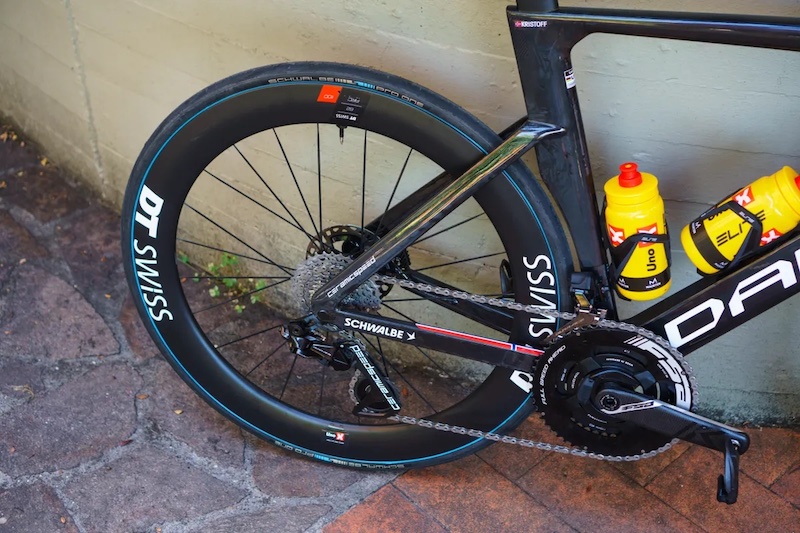
Anders als das neue Trek Madone SLR verwendet das Velocity Ace standardmäßige, nicht integrierte Flaschenhalter mit runden Fahrradtrinkflaschen.
Es kann jedoch sein, dass das neu gestaltete Unterrohr in diesem Bereich eine bessere Luftstromsteuerung bietet als zuvor.
Am hinteren Teil des Fahrrads wurden die Tragflächenprofile von Sitzrohr, Sitzstreben und Sattelstütze ebenfalls deutlich vertieft.

Ob dies Auswirkungen auf die Konformität hat, bleibt abzuwarten. Abgesehen von den abgesenkten Sitzstreben scheint Dare jedoch keine großen Zugeständnisse in Sachen Komfort gemacht zu haben.
Like some time trial bikes, the seatpost appears to have multiple saddle clamp locations, enabling a rider to adjust the effective seat tube angle – an important consideration for fit purposes.
One of the deepest handlebars we’ve seen
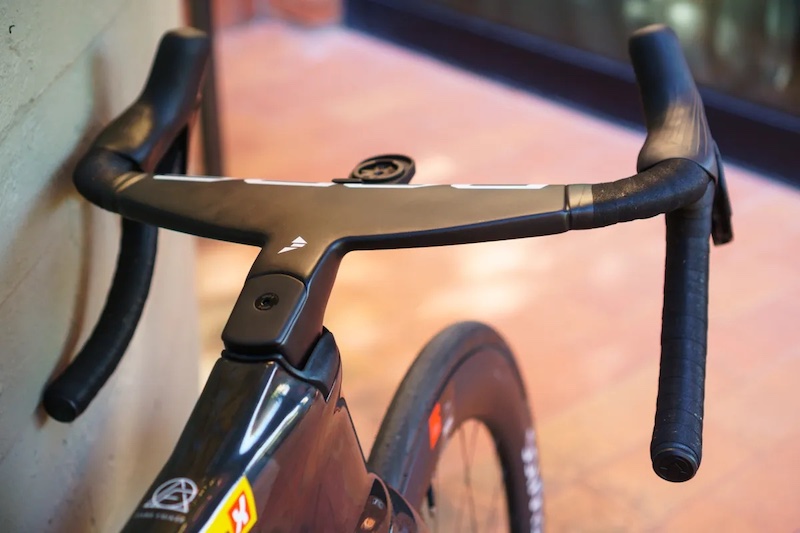
Beyond the head tube, the bike’s new aero handlebar is also remarkable, thanks to its use of an exceptionally deep and thin aerofoil profile on the tops.
Expectedly, the handlebar uses an integrated design, with the hydraulic brake hoses fully concealed within the bar and running into the frame unseen.The top tube rises to meet the rear of the stem, while the headset top cap has been cleverly profiled to smooth out the junction between the two.
Overall, Dare’s new bar appears to take the opposite approach to Ribble’s ground-breaking Ultra handlebar (which features on the Ultra SLR). The Ribble bar uses a similarly deep aerofoil profile, but is much more bulbous, as it’s designed to manipulate the airflow hitting the rider behind it.
Notably, Trek says the updated handlebar on its recently launched, eighth-generation Madone SLR does something similar (albeit on a smaller scale).
The Dare handlebar, in contrast, looks to be designed simply to reduce its impact on the airflow as much as possible.
As with rear-end comfort, there doesn’t seem to have been much consideration for a rider being able to hold the tops of the handlebar. As with the rest of the bike, it looks to be all about maximising aerodynamic efficiency.
On this bike, which belongs to four-time Tour de France stage winner, Alexander Kristof, the cockpit combines a 120mm-long stem with a 380mm-wide handlebar (measured centre to centre at the brake hoods).
The frame also has a logo noting the headset contains CeramicSpeed's SLT (Solid Lubrication Technology) bearings – which are claimed to provide exceptionally long lifespans, reducing the frequency with which the front end requires servicing.
A speed-focused build with personal upgrades
The rest of the build sees an uncompromising focus on speed.
Like last year, Kristof’s wheelset of choice is the DT Swiss ARC 1100 Dicut DB, with 62mm-deep rims.
These are wrapped with Schwalbe Pro One TLE tyres, in a 700 x 28c size that measures up at 27.9mm-wide on the DT Swiss rims.
As with last year, the tyres have conspicuous blue accents that don’t come on the versions of the Pro One TLE available in shops.
Having spotted these last year, we asked Schwalbe if this was a new, updated version of the German brand’s highly-rated tubeless tyre. Unfortunately, the brand declined to shed any light on the subject.
According to our well-informed YouTube audience, though, these could be special-edition, race day-only versions of the tyre – something faster, lighter but potentially less durable than the standard tyres, for example.
Schwalbe has apparently created similarly-branded tyres for its sponsored mountain bike athletes previously, so that could be what’s going on here.
As for the drivetrain, Kristof and his Uno-X team are still running Shimano’s flagship Dura-Ace Di2 R9200 groupset.
This year, though, the team has switched from using Shimano’s Dura-Ace FC-R9200-P power meter crankset to FSA’s Powerbox Team.
This consists of an FSA power meter spider (which we believe is made by Power2Max) paired with the brand's carbon cranks and aluminium chainrings.
When we saw Kristof’s bike, a couple of days out from the race start, it was equipped with some huge 56/40t chainrings.
Even though these were paired with a wide-ranging 11-34t cassette out back, we wonder whether Kristof might have swapped to something smaller for the race’s mountainous opening stage.
Perhaps due to a change in team sponsor, Kristof has switched saddles from the Pro Stealth Curved Team he used at last year’s Tour to a Prologo Scratch M5 with carbon rails.
Finishing things off, Kristof’s bike was also decked out with CeramicSpeed’s latest OSPW (Oversized Pulley Wheel System) RS Alpha and a waxed chain.
The 'Alpha Disc' solid pulley wheels are claimed to prevent dirt or debris entering the system and contaminating the bearings.
A new bike that’s heavier than the old one
It’s rare to see a new road bike released that’s significantly heavier than the outgoing version, but that’s exactly what we have here.
According to Dare, the VSRu had a claimed frame weight of 1,190g in a size small (although Kristof rides a 56cm frame). While we don’t yet have a claimed weight for Velocity Ace frame, we think its deeper tubes and aggressive aerodynamic optimisations have likely added weight.
That appears to be confirmed by the overall weight of Kristof’s Dare Velocity Ace, too, which came in at spot-on 8kg, according to our scales.
That’s 255g more than the 7.745kg weight we took for his Dare VSRu at last year’s Tour.
As things stand, that’s all we know about Dare’s radical new aero road bike.
Given a number of Uno-X riders are using the bike at this year’s Tour, it appears the bike is production ready and could launch imminently.
Frameset: Dare Velocity Ace (size 56cm) our Tour recycling have similar aero road carbon bike frames hotsale such as TDC-RD49,also developed new aero super weight road frame design TDC-RD55. these designs are more advanced and high performance in our customers. Welcome to send your inquiry to brand your new markets.
Groupset: Shimano Dura-Ace Di2 R9200 with FSA PowerBox Team power meter (56/40t chainrings, 11-34t cassette), FSA carbon cranks, CeramicSpeed OSPW RS Alpha and UFO waxed chain
Wheelset: DT Swiss ARC 1100 Dicut 62 DB
Tyres: Schwalbe Pro One TLE 29c (measured width 27.9mm)
Bar/stem: Dare, 38cm handlebar width, 12cm stem length
Seatpost: Dare
Saddle: Prologo Scratch M5 Nack
Bottle cages: Elite Vico Carbon
Pedals: Shimano Dura-Ace
NOTE: MAIN ARTICLE FROM WEBSITE